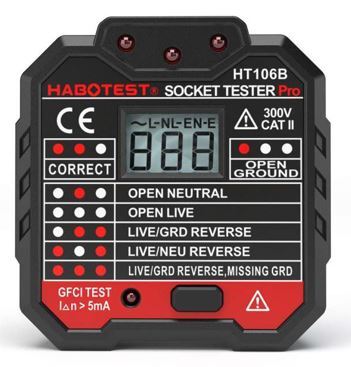
I used the above GFCI/RCD (up to 250v) socket tester on the 240v black and red live wire of the US split phase ac power system. When I connect the ground, all indicator lights (3 red) got on indicating "Live/Grd Reverse, Missing GRD" although it is connected properly.
What is inside the socket tester? Does it have a live and neutral leg such that it should only be used for ac system with polarity? How about if you use it on the red and black 240v phase to phase? Why would all the indicators light become on (3 red lights)?
The following is the specs of it:
Specifications:
Brand Name: HABOTEST
Color: Black
Material: Flame Retardant ABS
Plug Type: US
Voltage: 48V-250V 45-65Hz
RCD Test: >30mA (EU/UK Plug)
RCD Working Voltage: 220V±20V
GFCI Test: >5mA (US Plug)
GFCI Working Voltage: 110V±20V
Voltage Measurement: 48V~250V / 45~65Hz
Accuracy: ±(2.0%+2)
Working Environment: 0°C ~ 40°C, 20% ~75%RH
Storage Environment: -10°C ~ 50°C, 20% ~80%RH
Safety Rating: EN61010-1,-2-030, EN61326-1,CAT II 300V
Item Size: 62 * 65 * 55mm / 2.4 * 2.6 * 2.2in
Item Weight: UK 64g/2.3oz, EU 59g/2.1oz, US 53g / 1.9oz
Package Size: 7.5 * 7.4 * 7.3cm / 3.0 * 2.9 * 2.9in
Package Weight: UK 90g/3.2oz, EU 86g/3.0oz, US 79g / 2.8oz


Best Answer
Magic 8-Ball
Harper calls these "magic 8-balls". If you don't really understand them, they are about as useful as a Magic 8-ball.
The original versions of these (and still available) have 3 lights connected across hot-neutral, hot-ground, neutral-ground. The newer testers - like yours - use a microprocessor and some fancy circuitry to simulate the 3 lights and provide additional information.
Wrong circuit!
While this particular device (and many others) can handle a wide range of voltage & frequency (just like a laptop power supply or many other things), it does require a particular combination of wires to work as designed:
One key thing to remember is that the electrons moving around (usual metaphor for electricity, though the physicists argue about the details) do not "know" what is supposed to be Hot, Neutral or Ground. They just "go where they can, the fastest/easiest way that they can get there". That is why problems with "lost leg", "lost neutral", "ground fault", etc. can be so dangerous. But it is also why a tester like this is extremely limited in what it can tell you. It can sort of say something is "reversed", but only if everything else is normal.
You connected, TWO HOT WIRES and no neutral. So things won't work right, as you found out the hard way. Among other things, Neutral to Ground is 0V on a Hot/Neutral/Ground cable but you replaced Neutral with another Hot wire, so Hot -> "Neutral" is 240V instead of 120V (that's OK on this particular device) but "Neutral" -> Ground is 120V instead of 0V, which is not OK - and turns on an extra light.
How the lights are SUPPOSED to work
Light 1: Hot -> Neutral. Normally ON. Off if Hot or Neutral is open (because the light can't get power from an open circuit) or if Hot and Ground are reversed (because Ground and Neutral are normally bonded so no power flows between them)
Light 2: Hot -> Ground. Normally ON. Off if Hot or Ground is open (no power in an open circuit) or if Hot and Neutral are reversed (because then this is Ground and Neutral).
Light 3: Neutral -> Ground. Normally OFF. On if Hot and Ground are reversed (because then this is Neutral & Hot) or if Hot and Neutral are reversed (because then this is Hot & Ground).
So each particular light tells you about voltage between two wires. But it doesn't really tell you what is going on. The combination of all 3 lights gives a good indication of what is likely to be going on.
The Problems
There are a lot of possible problems. Let's start with one that is clearly a problem on this device: All lights on == Live/Ground Reverse, Missing Ground
Guess what? There is NO SUCH THING!
My trusty Klein RT105 doesn't have "all lights on" on the label? Why? It does not exist in any normal circuit - and if it exists, the magic 8-ball has no idea what it means!
It can't really mean Live/Ground Reverse AND Missing Ground - if the Ground is missing, it is not "reverse"! They really should not have put that label on there - better to just leave it as "all lights on should never happen, so we'll just pretend it can't happen - and except for someone trying to put in a 2nd hot instead of neutral, it doesn't happen.
All it really means is "enough voltage on all 3 pathways to turn on the lights". In your case, that is:
There are additional possible problems, such as blinking or dim lights, which could mean all kinds of possible problems with your circuits.
The end result is that:
I mainly use these as a double-check. If everything seems OK and the tester shows the correct lights, I'm good to go. If something already seems "wrong", this kind of tester doesn't tell you much of anything. And if I am going to a new (to me) receptacle to check things out, then the tester gives me a very good first indication of correct/incorrect - but if it says incorrect then it is time to open things up and check everything methodically until I figure out the problem.